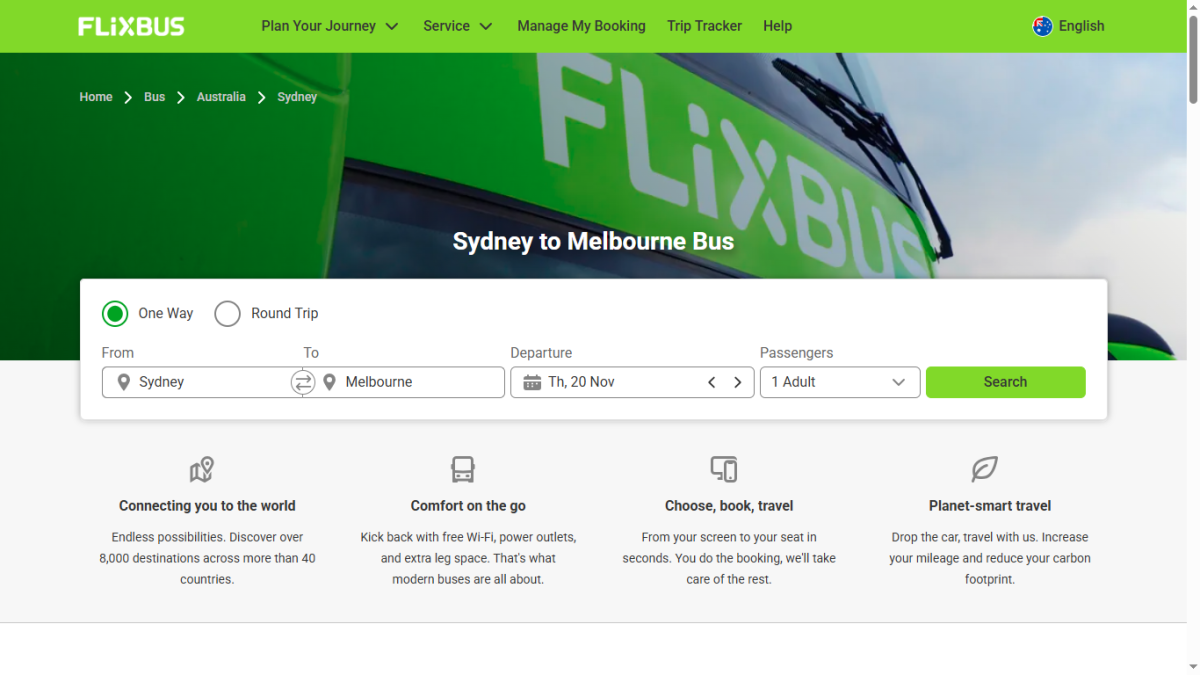Last Updated on: 1st November 2025, 06:19 pm
Let’s face it. Christmas in the southern hemisphere is for the most part, boring.
If you haven’t heard of it already: introducing European Christmas markets.
Forget about lame popup shopping center Christmas villages and boring Christmas “markets” selling modern products under plastic covered stalls on wonky plywood tables.
To really get into the atmosphere of Christmas, you really need to go to a Christmas market in Europe.
Christmas markets originated in Germany in as early as the 16th century, and they still have some of the best Christmas markets around. This guide will introduce you to them and tell you how to get the most out of them and in particular, talk about Hamburg Christmas markets.
Jump to each section:
Are Christmas markets worth going to?
What to do at a Christmas market?
• Shopping
• Drinks
• Food
Tips for first time visits to a Christmas market
Things to note
• Buying drinks
• Buying souvenirs
• Public toilets
• Paying
• Souvenir alternatives
Best way to get to a Christmas market
When to vist German Christmas markets
Some Christmas markets around Hamburg
• Jungfernstieg
• Rathaus
• Gänsemarkt
• Lübeck
What are Christmas Markets?



Christmas markets are outdoor markets that are set up around Christmas time, where traditonally, artisans sold handcrafted goods, dried meat products, sweets, nuts, dried fruit, baked goods, wooden toys, food and drink, and Christmas decorations like candles, lights, and star figures or adorable clay houses with real smoking chimneys. Although common throughout Europe, Christmas markets started in Germany, where they are called “weihnachtsmärkte” (plural). Today, they are visited by both locals and tourists.
The markets are set up the first week or so of November, and open mid-November until the end of December or even start of January for larger ones. It is free to enter and a great place to get some authentic local souvenirs. Locals visit the makets after work and school to hang out, get dinner, and go shopping, so the markets get busier and more fun after dark.
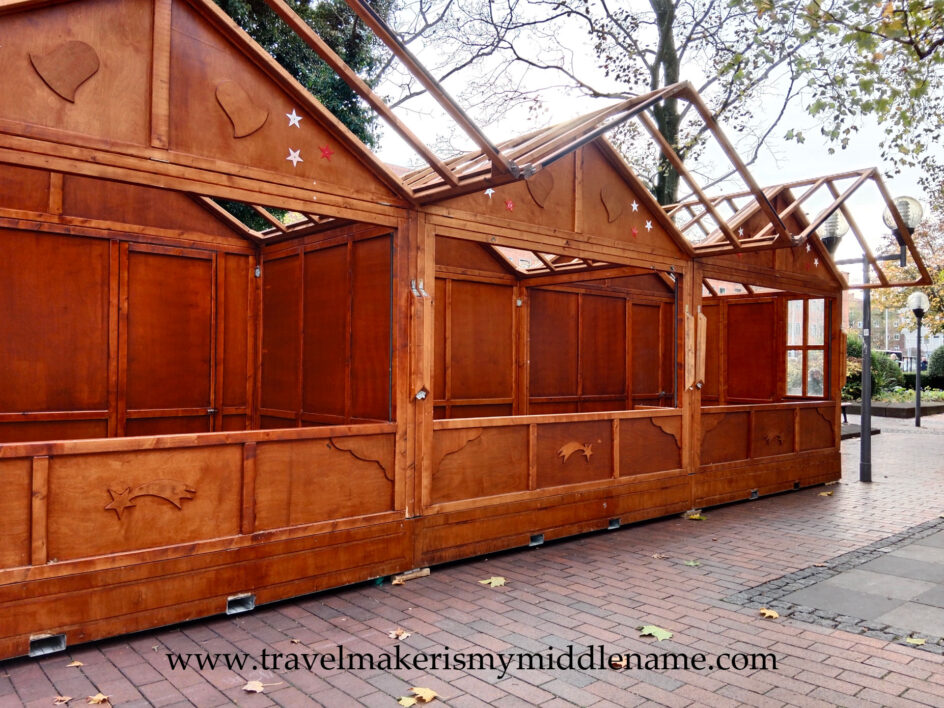


While European Christmas markets in major cities are set up in large open spaces, most Christmas markets in Germany in small towns are set up around the local church. This is because prior to modern modes of transportation, people lived in more or less small, isolated communities scattered around and clustered within walking distance to the local church. This meant the church became the social center of every day life, and also the location of markets. In small towns, a church is never far away from the Christmas market. You can hear the church clocks hourly at the market in Lübeck, below.



Today, it attracts not only locals, but also tourists from around the world.
Are Christmas markets a tourist gimmick? Is it worth going to?
Christmas markets are absolutely not a tourist gimmick and is absolutely worth going to. They are a German tradition that have been around for hundreds of years and are not a gimmick made for tourists. They are places that the locals go to, so you can be sure you are getting an authentic experience. Christmas markets are popular seasonal destinations on their own and millions of tourists go to Christmas markets in Europe every year.

You haven’t celebrated Christmas and, dare I say this, experienced the true magical feeling of Christmas until you have been to a live Christmas market (while there are year round “christmas” markets (shops dedicated to seling Christmas themed products), the atmosphere is a lot better if you go to a real one).

Christmas markets in Germany are not just about shopping for a Christmas gift or ornament. While I was living in Germany, I went once and then I was hooked. Christmas markets in Germany and indeed, Europe, is about the atmosphere of being amongst the crowd of excited people during a major holiday. It is about the sights of lights, the sounds of music and people chattering, the wonderful smell of roast pork, baked goods, roasted nuts, sweets and glühwein, and of course, the adorable authentic looking timber huts that house the stalls that are a far cry to the plywood and plastic stalls you find in places like Australia.

While large Christmas markets in the city have more stalls, markets in smaller towns can be just as popular. The Christmas markets in small towns like Lübeck in Schleswig Holstein, is highly popular and you will see them in every travel brochure selling trips to Germany, particularly Christmas trips to Germany. Lübeck is a medieval town with original, medieval architecture churches and cobblestone grounds. Its adorable Christmas market selling traditional wares is set amongst old stone buildings, cobblestone alleyways with a medieval church in the background and church clocks ringing every hour, all within easy reach of public transport, is a draw card indeed.
What can you do or buy at a Christmas market in Germany?
Christmas markets, especially in large cities like Hamburg, is not just a shopping destination where you can pop in and out in ten minutes to grab a last minute gift. It is a destination of its own.
The stalls are contained in adorable timber huts that are set up in early November. The huts are decorated with greenery and arranged custered together to resemble a village layout, and the “village” is decorated with more pot plants and real Christmas trees. Some huts are small used for stalls that sell to customers for take away shopping, other huts are large and can hold tables and chairs for crowds of customers, these are for dine-in food halls, or for larger shops where customers can walk in to examine the goods. These are good places to get away from the cold for awhile.
There are three things people go to Christmas markets for. The food, the drinks, and the shopping (and also the atmosphere).
Shopping

In modern times, Christmas markets in Germany are typically managed or operated as a private business, meaning stall holders rent a stall from the operators to set up a shop at that market. In order to keep the experience authentic and to prevent it being “cheapened”, stall holders go through a rigorous process by the operators, allowing only the ones that fit their criteria. Different markets have different criteria they look for in their stall holders, which are published on their website. In the vast majority of cases, operators mostly look for unique and hand crafted products by artisans to avoid markets being flooded with mass produced factory made items. That is not to say there aren’t factory made products, but you can expect them to be better quality or unique in some way. Some markets specialise in a particular area, for example the Reeperbahn Christmas market.
Traditional items you would find at a good German Christmas market are wooden toys, which stems from people constructing decorations and toys out of material they have easy access to (wood), nutcrackers, candles, house and tree decorations, large light up stars, artisan dried meats, wines, jams, hand made figurines, and scarves. You can also find more modern items, as long as they fit in with the market operator’s criteria.
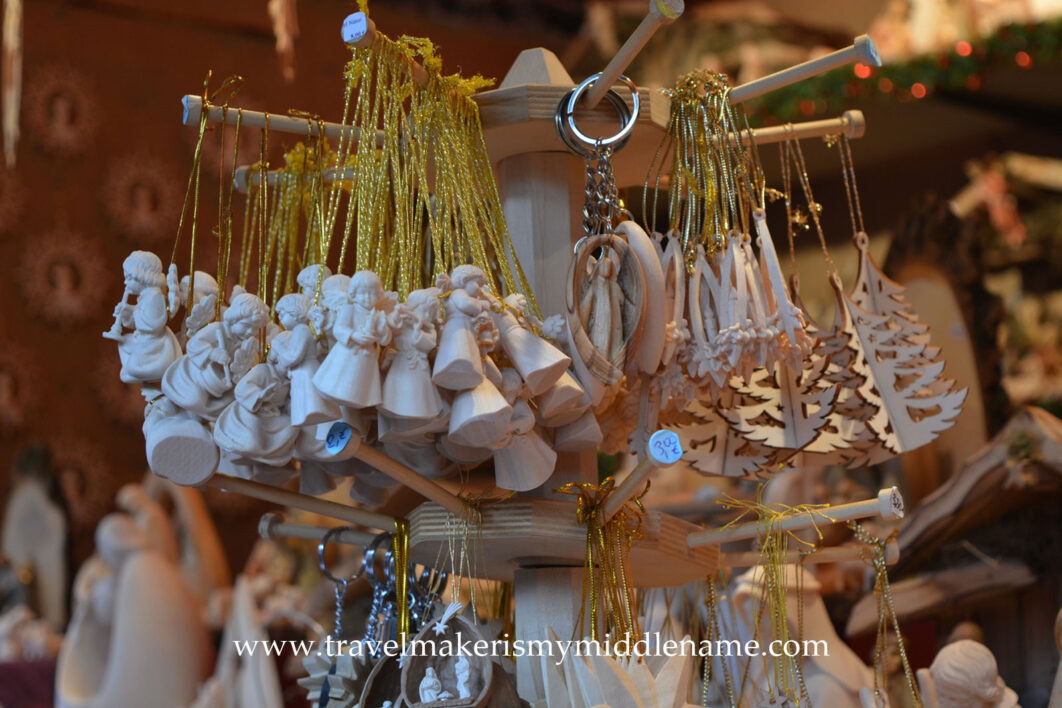

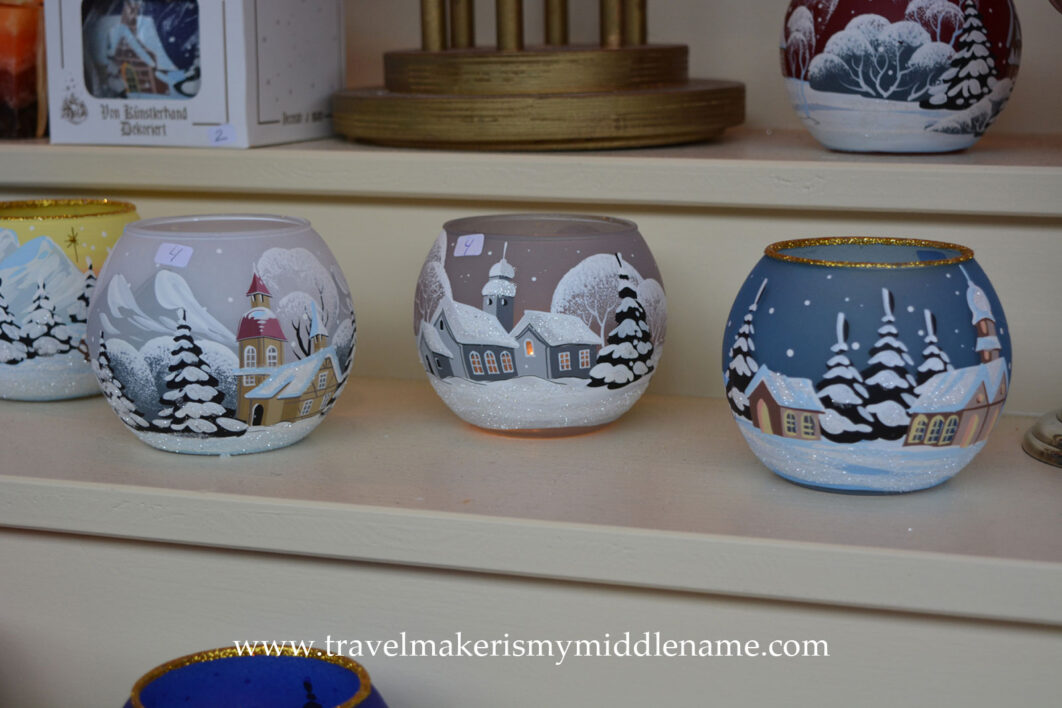





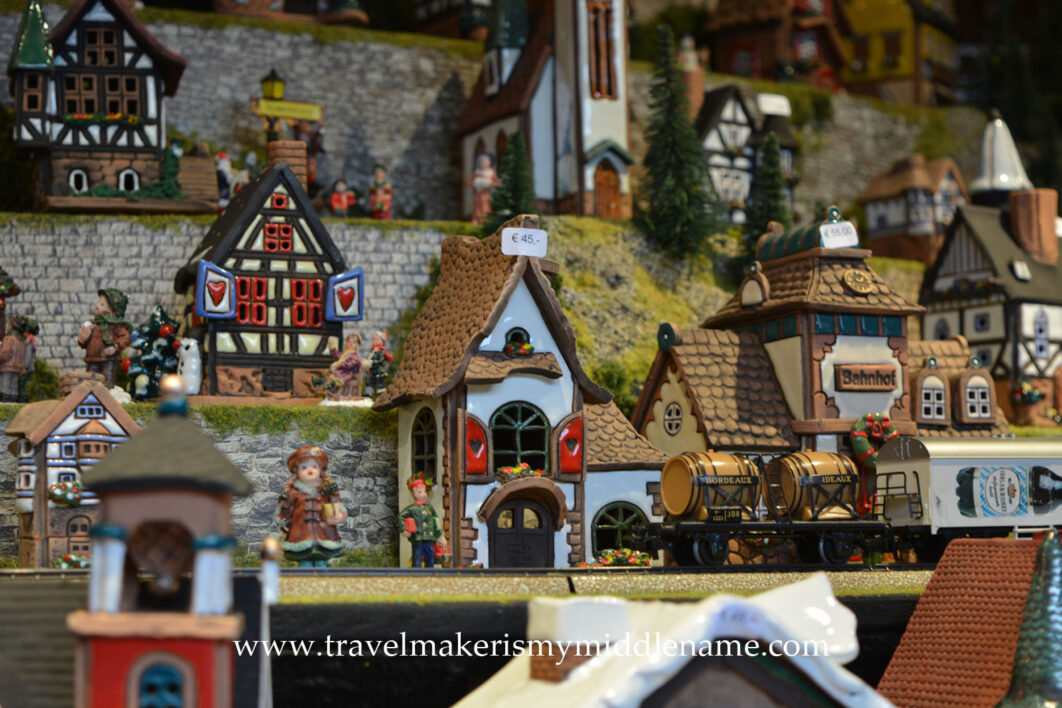


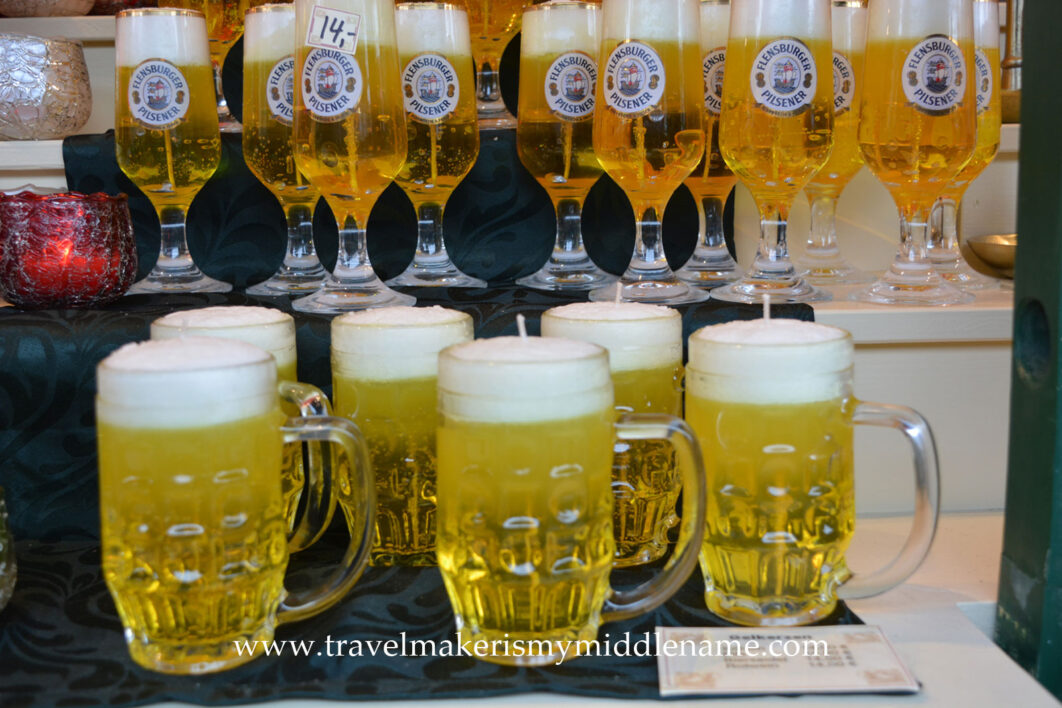




On thing that makes stall holders of German Christmas markets different to stalls in other countries (like Australia for example) is that the stall holders must be registered businesses. So, not everyone can simply rent a stall and sell homemade cookies. Demand is high and sells out early in the year, and operators choose only the most interesting or best products. Part of the vetting process is where they ask the applicant to describe their product. Popular products and businesses are more likely to be there every year at the same market and indeed, the same spot. Regular visitors to Christmas markets become familiar with the markets and know the long term tenants.

The Christmas market is an excellent place to go for window shopping, even if you don’t buy anything, and is an excellent place to spend the day or a few hours if you are looking for something free (to enter) to do.
Drinks
Glühwein is not only part of the Christmas tradition, it is synonymous with Christmas in Germany. It seems not matter how small the Christmas market is, there is at least one stall that sells glühwein, even a small neighbourhood Christmas market. In short, glühwein is a guaranteed part of any German Christmas market and earns the stall holder and the market owner good profits. Therefore, trying glüwein is an activity that is always recommended to tourists to for the authentic experience.


However, although it is heated, glühwein is still alcoholic, and can cause intoxication if consumed in excess. At the end of the day, alcohol is a drug, albeit for some reason a socially accepted one, and no amount of alcohol is safe. Although I never condone consumption of alcohol, tracking down the best glühwein can be a goal of Christmas market goers. Not all glühwein is the same, some places mixes their own, others buy supermarket glühwein and simply heat it up and sell it for the same price per cup as it cost to buy a whole carton. If you are choosy, hang around the stall while the staff work and see if you can spot where they get their glühwein from – a carboard carton of supermarket glühwein or if they make their own.
Warning: Never drink alcohol when pregnant and remember that glühwein can still cause intoxication, do not drive after drinking glühwein or any other alcoholic beverage.
If you prefer not to, or do not consume alcohol, you can try Kinderpunsch instead, which is basically the same thing but without the alcohol. Kinderpunsch is a sweet, heated grape juice (although can also contain apple juice) flavoured with “Christmas themed” spices like cinnamon and nutmeg. Fair warning though: it can be very sweet.
Other drinks available are hot chocolate, coffee, and egg nog. Specific drinks can vary at different markets.

See the note on drinks below in the “things to note” section.
Food
You can’t go to a German Christmas market without trying the food there. After all, about half of the stalls there are dedicated to food, and food in any country is always one of the best ways to experience the culture.
There is a large variety of European specialties at Christmas markets, and one can get lunch or dinner there, as well as snacks and dessert. Typical selections include roasted meats with sauerkraut, Dutch pancakes, flammkuchen, soups, roasted nuts, chocolate covered fruit (a real specialty considering how difficult it is to get plump, fresh fruit in winter), sweets, dried fruits, cheeses, potato spiral chips, pretzels, hot food and drink, and baked goods. Other things you might find depending on the market include spices, chocolate, and tea.
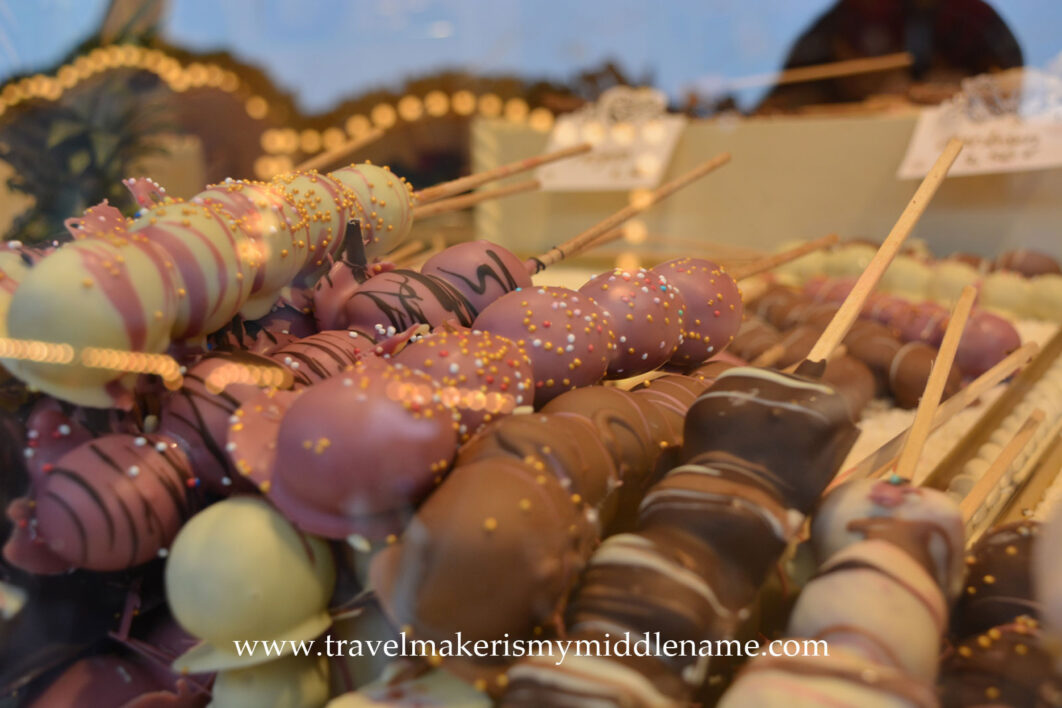














Foods I recommend you try
Hot chocolate

If you’ve never tried hot chocolate in winter, you should. A good quality, hot, hot chocolate on a cold winter’s night topped with whipped cream is a delicious sensation. Even better is you can keep the cup afterwards if you want.
Roast pork and sauerkraut

You can’t go to Germany and not try the roast pork and sauerkraut, a delicious combination of juicy, savoury meat complimented with tangy sauerkraut. Even better if it comes with roasted potatoes.
Wurst

Germany is also famous for their sausages, and you can buy a variety of sausages at Christmas markets, with or without bread rolls. They come chopped up with sauce on a small paper plate. I recommend the currywurst, which is sausage served with curry flavoured sauce and curry powder. For those who can’t get enough, you can also buy curry flavoured tomato ketchup in the supermarket. Look out for the round, cylindrical red bottle.
Some sausages are cooked on an electric grill, but for a more fun experience, be sure to look out for stalls that have a giant round dish or grill hanging from the ceiling. Giant dishes or grills used for cooking are suspended from the ceiling over a fire or some hot coals. These are found in (usually) round huts with the dish in the center. This ingenious design does three things at once: cook the sausages, warm up the workers inside, and if the hut is round, customers can see and approach it from any angle and location. Since the fire is on all the time, the workers simply toss a bread roll onto the dish behind them to warm it up when a customer buys a sausage. Check out the video below. Although this particular hut is not round, the rest of the principle applies.
Roasted almonds

There are a variety of roasted nuts in a variety of flavours, but the sweet roasted almonds are the best. Sold in 100g serves, they can be a little pricy, but they are so delicious and addictive, you can’t help going back for more. You can buy a larger serve to save some money and share with friends. Best if eaten hot!
How long to spend at a Christmas market + tips for first time visitors
Depending on the size of the market and what you are there for, you can spend anywhere between an half hour to several hours. As a guide, 3 hours is a good minimum amount of time to set aside for a large market like the ones at Hamburg. You may want to add some more time in case you’re one of those people who find it hard to leave a fun place once you’re there, like to look at things in detail, going for shopping purposes (and need time to compare and consider), plan on trying all the food, and/or are indecisive and can’t even decide what to look at first. Large Christmas markets can be overwhelming, so it’s good to have a plan of what you want to see so you see everything instead of running around mindlessly, for example, stay on one side of the stalls and go around the entire market, or do it row by row, one side at a time. If visiting with a group, decide on an obvious meeting point to meet at later. Keep an eye on the stall names and numbers in case you want to go back later.
In contrast, the Lübeck market can be seen in around 2 hours, with the same considerations as above. I actually spent longer at the Lübeck Christmas market because there were more photo opportunities and I went there specifically to buy things. The atmosphere there is also different due to its setting of being near a medieval church and on cobblestone grounds. There are even small, or tiny community Christmas markets scattered in neighbourhoods, for example in Kiel, which could be seen in mere minutes, but these are more of a hangout for locals who don’t want to go far, than an attraction for tourists.
If you stay at a hotel close to a Christmas market, you can wander down any time during their opening hours for a browse.
One you know what you are looking for, you can actively seek it out and use less time at the market.
Note: You should bring your own bags for your shopping in case the stall doesn’t provide them. Some stalls have bags but not all do.
Things to note
Buying drinks
Germany is renowned for being meticulous about sorting their trash. In order to stay environmentally friendly, places that sell drinks uses a resusable ceramic or glass cup with a deposit and refund system where the customer is charged a depost of around 2€ per cup, for which you get a refund called a pfand, when you return the cup to them to be cleaned and reused (this is the same system that applies to all drink bottles for enjoyment beverages like juices and soft drinks at supermarkets). The price of the drink listed on the menu doesn’t include the pfand, the pfand is listed separately, so when looking at the price, keep in mind you will be charged more than what the price of the drink is.
Tip: the drink mug is an excellent souvenir!
You may choose to not return the mug that the drink came in, and instead keep it as a souvenir, like many people do. This is an excellent idea since it is a truly unique souvenir that you won’t be able to get anywhere else at any other time. This is because the mugs are decorated with the name of the city or town the Christmas market is in, and the year, so a lot of people collect them. The mugs can come in all shapes and sizes and you can ask for your preferred one when you order a drink, and effectively at only 2€ for the mug, you get a drink AND a souvenir to keep that you can continue to use repeatedly. You won’t be able to get a value for money souvenir anywhere else.
If you don’t want the drink, you can buy the mug just by itself for the cost of the pfand.

Buying souvenirs
There are two things to consider when buying souvenirs. The first is how you will get them home, and the second is regionality.
Transporting large/fragile souvenirs
If you live locally, it might not be so much of a problem getting souvenirs home from the market, but if you are visiting as a tourist from abroad and plan on buying large and/or fragile souvenirs, you should plan ahead and think about how you will get the item back to your hotel and indeed, back to your home. Don’t rely on stall holders to have protective boxes for your souvenir – at most they might have bubble wrap and a marketing package. A hard box such as a cardboard box preferably with a lid or flap is best, or for small items, you can get cheap plastic lunch boxes at 1-euro shops (the equivalent of dollar shops). You can get free boxes at supermarkets (Aldi, Lidl, Penny, are the main discount stores that have a lot of boxes, other supermarkets include Rewe and Edeka). When packing them in your suitcase, you can use clothes to cushion fragile items inside the box. If possible, you should go check out the Christmas market before you buy your souvenirs so you know what is available and have an idea of what you want to buy, before you make the acutal purchase.
For example, the clay model of the Hamburg Rathaus (below) is over 40 cm wide.

The small hand made clay incense holder house came in a thin protective cardboard box (below). Even though it says “candle houses”, this one, like most of them, holds a small cone of incense that releases smoke when lit up, which escapes from the model’s chimney.

Regionality of souvenirs
There are quite a few large Christmas tree stall companies that have stalls in several towns/cities, and so their products will vary depending on which one of their stalls you visit. This is especially true for ornaments, figurines and decorations.
For example, the Christmas tree bauble below bauble is a hand blown, painted and decorated glass bauble that is in the shape of the Holstentor (Holsten Gate) in Lübeck. It was purchased in Lübeck from a Christmas market stall company that has stalls in several cities, including Hamburg. They are long term stall holders and each year always use the same stall location in their respective market.
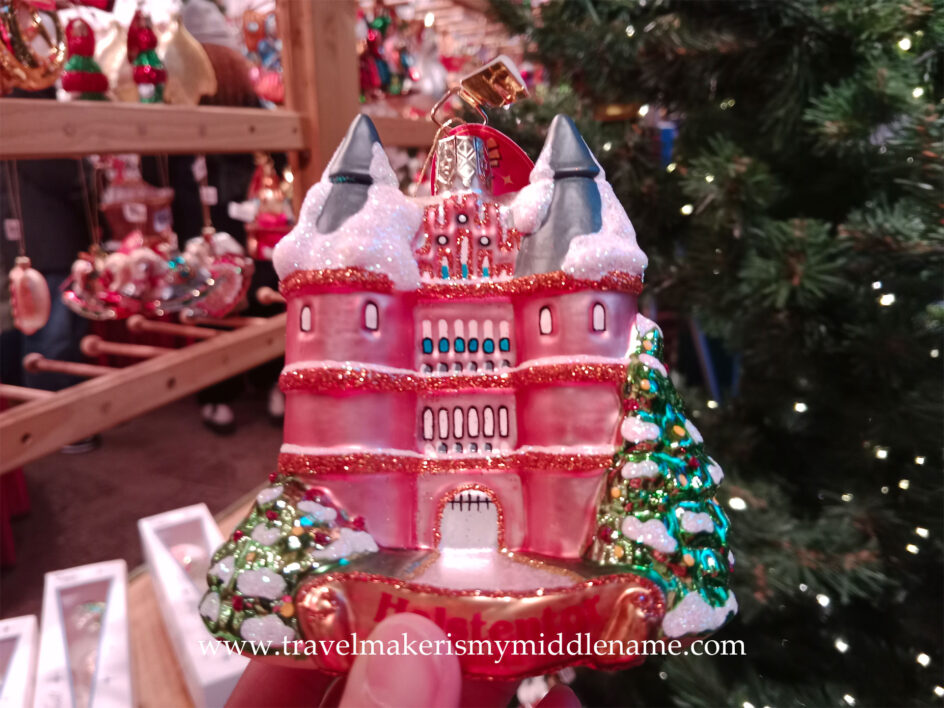

Also, as seen above, the company that makes the clay houses, has a model of the Hamburg Rathaus in the Hamburg Christmas market, which was not seen in the Kiel Christmas market where I purchased my own small clay incense holder house.
Public toilets
Public toilets in general in Germany and the rest of Europe charges money, usually 0.5-1.5€ per visit which train stations charging the higher end of the scale. Small children enter with a paying adult for free. Be prepared to have a few loose coins to pay for the toilet.
Paying for your purchase
Card payments are getting more and more widely accepted at temporary establishments like Chistmas markets, but you should always have cash just in case, since not all stall holders accept card.
Prices and how much you should spend | Souvenir alternatives
How much you should spend is a matter of your own budget. Keep in mind that artisanal products at an artisanal and most of all, Christmas market, like hand made or small batch items will cost a lot more than factory made items or things sold in everyday markets, so don’t be surprised if things cost more than you expect. In fact, expect prices in Christmas markets to be expensive. I’ve tried to show some prices of producs in my pictures here to give you an idea. I purchased a small clay incense smoker house and it was around 20€. You can see the prices of other clay house figurines in the photos.
The cheapest and most worthwhile souvenir would no doubt be the mug that drinks are served in. Many people collect them, and the market organisers know that people keep them as souvenirs, so don’t be afraid to keep yours. You can even just go directly and ask to buy a mug if you don’t want the drink. If you are on a small budget, this is the one souvenir I would definitely recommend.
If you are less of a foodie, perhaps you can spend your budget on souvenirs. If you don’t typically buy souvenirs, you can spend your budget on trying the food. If you go with a friend, you can share the food and pay half each, that, way, you can try more for less.
If you are after Christmas tree ornaments, you can also try shopping centers. There might not be artisanal ornaments, but there still could be some nice ones, and for less. Below are some cheaper alternatives.
For example, these LED light up tree and decoration ornaments (below) are significantly cheaper thank comparable ones at a Christmas market, but still look great.
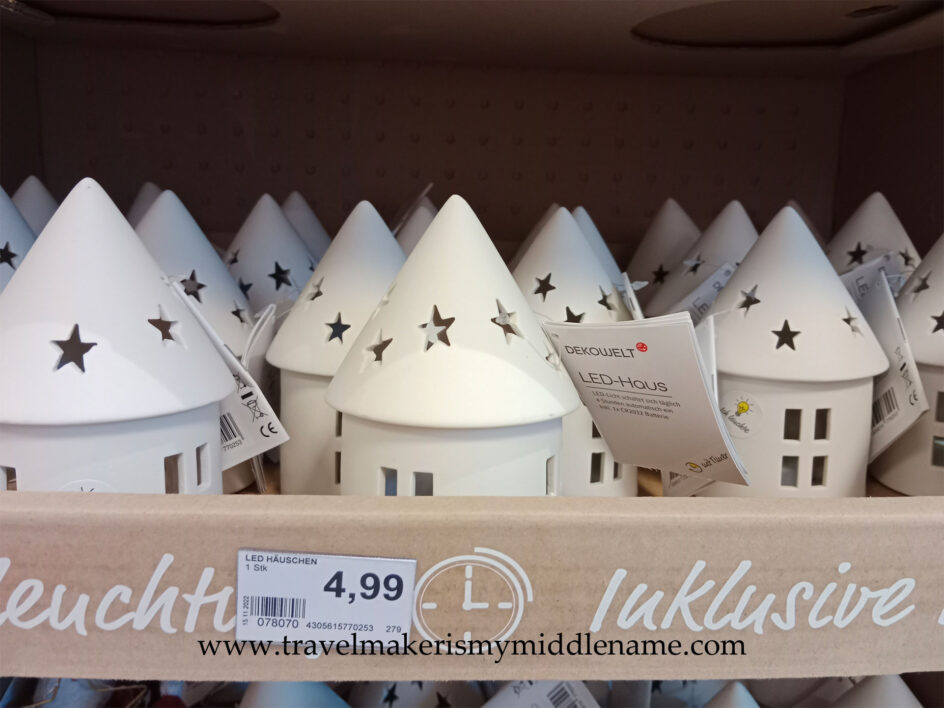






Best way to get to a German Christmas market
Christmas markets are well served by public transport, and parking may not be easy, so you should take public transport instead of driving.
When to visit German Christmas markets
Different markets have different exact starting and ending dates. The larger ones in the city are more likely to open until the end of December or even the start of January, but typically they start in mid November to Christmas day or Christmas eve. They open mid morning around 10-11am until 9pm, so you can sleep in and get brunch or lunch at the markets.
TIP: the atmosphere of the Christmas market is much more exciting after dark, because more people go there (after work and school), and the various decorative lights turn on.
In winter, it’s fully dark by 4:30pm (16:00) and the sun sets around 4pm.
This means there is no hurry to get there first thing in the morning (they don’t open till about 10 or 11 anyway) and you can do other things while waiting for it to turn dark. If you plan your day well, you can get a lot done by doing other things during daylight hours first, then going to the Christmas market after dark.
What to wear at the German Christmas markets
Christmas is winter time in Germany and it is sub-zero tempratures for most of Europe. You should dress warmly as the markets are outside and you will be wandering around outside. The markets are not indoors and are not “warm” in the sense that indoor places like shopping centers are heated, however, it might be slightly better protected against wind due to the huts around you. Check the weather report before you go.
Exact dates of snowfall is unpredicatable. Generally, in small towns, before the end of the first week or middle of December, although the weather might be cold, there might not be any snow, and the ground is dry. Towards the middle and later part of December, if you are lucky, snow might fall, meaning the ground will be covered in snow and water (melted from frequent foot traffic). However, cities tend to be warmer, and so might not receive any snow at all.

Even so, you should wear comfortable, warm, non-slip shoes since you might be walking around for hours.



There are some large stalls that are indoor food places with tables and chairs, but for the most part, there are no places to sit in Christmas markets – food is sold from stalls and meant to be eaten standing up at high tables or shelves along the stall.

My personal recommendation is that it is better if the shoes are waterproof and fully encloses your feet. The reason for this is, snow can collect along the kerb along the road or street. With a lot of frequent passing traffic and falling snow, the snow on the ground can melt and become slushy, which forms wet liquid puddles among the small piles of snow. While not so common, it is possible to accidentally step in one of the puddles getting on or off buses if they stop at an inopportune location and you can’t step over it, and you do not want to walk around for hours with wet feet at sub-zero temperatures. The locals manage with winter boots or ordinary sneakers and you certainly can too if you wear warm socks and be careful where you step.
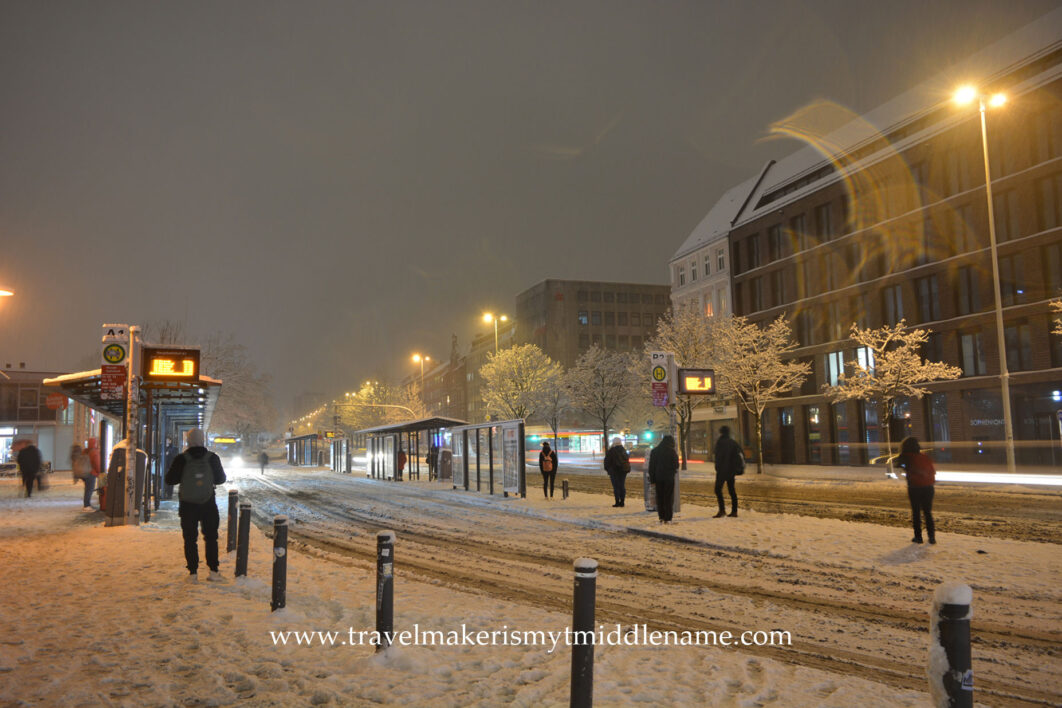
Hamburg Christmas market locations
Hamburg has several Christmas markets. Although they look pretty much the same inside, here are three I recommend:
Jungfernstieg “White magic of Jungfernstieg” (Weißer Zauber auf dem Jungfernstieg in German)
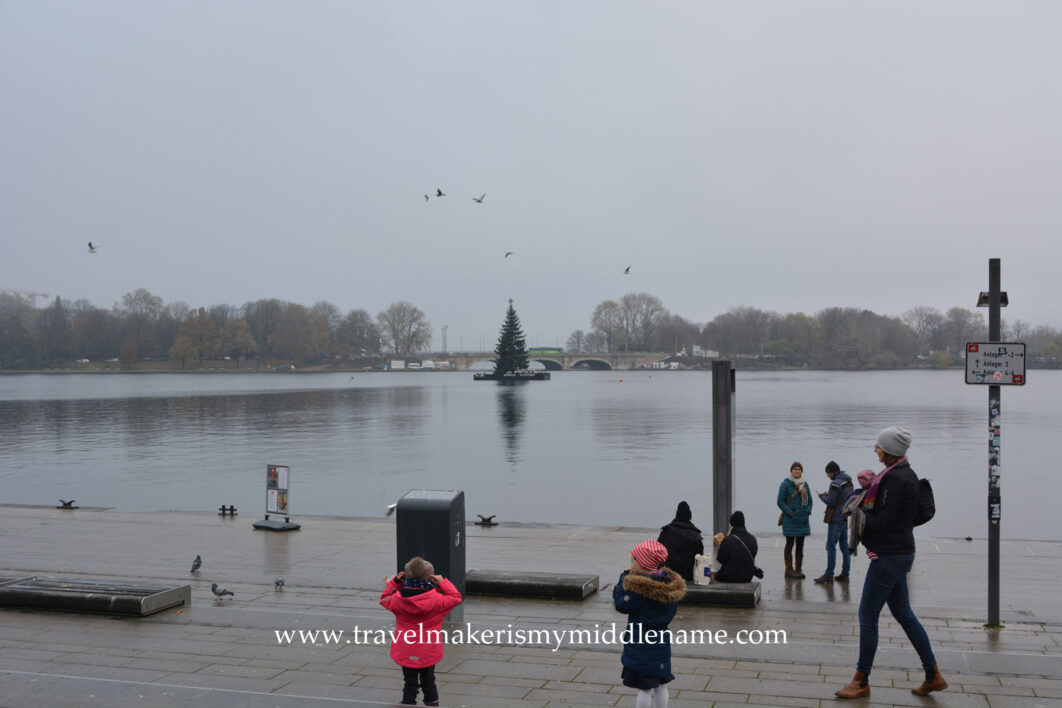
This is one of the most popular and largest Christmas market in Hamburg. It is located next to and along the water near Jungfernstieg. You can easily spend 3-4 hours here browsing all the stalls and trying out the food. There is a cute model train with real chugging sounds that runs on a railway track suspended over the roof of the stalls.
Rathaus: Historical Rathaus Market (Historischer Weihnachtsmarkt Rathausmarkt)

In Germany, Rathaus in any town is the local government office building. They are usually grand and important looking old stone buildings with a public square infront. The Rathaus Christmas market is then, naturally, outside the Rathaus building. Although not the biggest, the Rathaus Christmas market has a flying Santa and is set outside the impressive Rathaus building, so you can admire the building and check out the market at the same time. The Rathaus Christmas market is easy to access and close to the city center and the main train station (Hauptbahnhof) so doesn’t require a lot of travelling if you are staying in the city center.
Easy to access by bus or U-Bahn (underground metro), get off at Rathaus and you can’t miss it.
Gänsemarkt: Christmas light Gänsemarkt (Weihnachtlicher Gänsemarkt)
This is another major Christmas market in Hamburg that is again, located close to the main train station (Hauptbahnhof) and city center and is easy to travel to. You can access it easily by the U-Bahn or bus stop by getting off at Gänsemarkt station. It is actually very close to the Jungfernstieg Christmas market, and actually, when I first went there, I thought it was the same one. The Jungfernstieg market is spread along the water and one could easily end up at the Gänsemarkt Christmas market while strolling through the Jungfernstieg market. In fact, Jungferstieg is just 300m away from Gänsemarkt. That’s the great thing about Europe, historically, their towns are small and a lot of things in the community are within walking distance.
Visitors to the Gänsemarkt Christmas market can browse through the stalls and see the Christmas Parade nearby on Mönckebergstraße on every one of the four Advent Saturdays (the four Satudays before Christmas, in 2024 they are November 30, December 7, 14, and 21) at 2pm and 5pm local time.
To see details about other markets, visit the Hamburg tourism site here. TravelMaker is not related to Hamburg tourism.
Lübeck


Not in Hamburg, but if you have the time, Lübeck is just a ~50 minute direct train ride away from Hamburg. The Christmas market is a 2-3 minute bus ride from the train station. The Lübeck Christmas market has regional products that you can’t get at Hamburg (at least not when I visited) like the spices shown above, and the Holstentor bauble. Unlike the Hamburg ones which are set in the city, the Lübeck one is set in the medieval cobblestone area near the church and has a much more fun and cosy vibe. If you go during the day, you can even check out the Niedregger marzipan shop while you wait for it to turn dark.
Thank you for visiting my website. Please donate to my personal fundraiser if you can, or share my fundraiser if you cannot. I wouldn’t be asking if I had other options, and if everyone pitched in, my goal can be achieved. You can read about me on my About page. Thank you.
©All rights reserved for all content and photographs, usage on 3rd party sites are forbidden without permission. Photos are taken by author unless otherwise stated.





